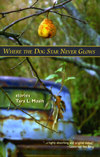Where the Dog Star Never Glows
Tara Masih’s short fiction has appeared in a number of well known journals for over a decade now, but Where the Dog Star Never Glows is her first collection of fiction. It does not disappoint. With seventeen stories, variety is the best word to describe this slim volume. The settings range from colonial India, to present-day Dominica, to the ‘60s USA, with lots of side roads taken. Though the prose style is consistently traditional – form is played with only slightly, and reality is always, more or less, real – the characters, themes, and content vary pleasantly, creating a dynamic and interesting collection.
Tara Masih’s short fiction has appeared in a number of well known journals for over a decade now, but Where the Dog Star Never Glows is her first collection of fiction. It does not disappoint. With seventeen stories, variety is the best word to describe this slim volume. The settings range from colonial India, to present-day Dominica, to the ‘60s USA, with lots of side roads taken. Though the prose style is consistently traditional – form is played with only slightly, and reality is always, more or less, real – the characters, themes, and content vary pleasantly, creating a dynamic and interesting collection.
The highlights of the collection are, in this reviewer’s opinion, the flash fiction pieces. This comes as no surprise, as Masih is the editor of a well-regarded guide to writing short-short fiction. In these petite stories, she manages to encompass a whole world with elegant precision, such as the woman who speeds down a road in “Suspended” and notices an animal crossing her path “in one of those moments that escapes the careful assumptions of the unconscious, something that should not be there is there.” Or the father in “Catalpa” who wages an endless battle against the tree that drops seed pods and sticky flowers in his yard, yet who also never fails to notice the tree’s leaves after a rainstorm, “the water spilling, so that it looks like it is raining liquid sunshine only under the catalpa, not anywhere else on Earth.” There is a precision in her prose that manages to capture the larger essence of character, of world and worldview, in a single stroke.
Even in the longer pieces, when Masih has time to relax, as it were, she retains this precision. In one of the more surreal pieces in the collection, “Ghost Dance,” the main character is a lonely divorced man who has become the caretaker of an old mining town turned tourist attraction. Living alone amongst the empty buildings, after hours,
He would roam the dirt streets and wooden boardwalks. He hopped the acrylic barriers that kept tourists from entering too far into the store or house. He tried on hats, poked around in old tobacco containers and pipes, continued the game of solitaire left unfinished on the saloon table. On night when his cabin walls threatened to close in, he’d take his dinner of scrambled eggs or stew to the fancy house and eat at a mahogany table set for twelve, over which hung a working chandelier, or to one of the cabins and eat at a wooden table set with a humble bread board and pewter pitcher.
In short, he becomes part of their world, a ghost in a ghost town. Masih’s description is haunting and captivating, hitting that precise note where action and description are melded. Again and again, she accomplishes this sort of wonderful accuracy, this imagistic veracity, like the character Bridgette, who plucks the heads off black-eyed Susans as she walks, such that “a ragged path of petals, already browning in the sun, trailed behind her.” This is a perfectly balanced image of the young woman, coming at the start of the story and foreshadowing the events to follow.
Character and plot are strong points to this volume, to be sure, but the vast array of settings is completely breathtaking. The coalmining town of the 1920s is just as believable as the surfers’ paradise in the Caribbean, and both of these settings quickly transcend any notion of stereotype. I was most taken by the four page story “Memsahib,” set in colonial India, a quick sketch-like piece that describes the wife of the British governor of a province who sets up her easel to paint the streets of the town. Narrated by a local child who follows and watches this mysterious, almost god-like white woman, the story takes on the challenging theme of colonialism. The child watches the white woman paint a street scene, complete with beggar and stray dog, and, when the child gets too close and is scolded by her bodyguard, realizes that the woman “belonged where she was, on the outside looking in, the observer making her statement on the provincial scene.” The narrator grows up to paint in his own right, “mountains…a Hindu temple…a stream or valley,” scenes from the post-colonial world that has emerged. In this action he finds a bond with the white woman, a bond of art and an appreciation of what it means to observe and to have a viewpoint.
In this and other stories in the volume, Masih demonstrates that short fiction doesn’t mean small ideas. This is a global collection that uses culture as more than color. Asking what it means to be a tourist, to be ruled, to belong, she crafts stories that delve into the essential questions of human nature that are never overly dense and are always pleasant to read.





